#the wind god Ehecatl
Text


The Aztec Death Whistle ‘The Most Terrifying Sound in the World’
For those who want to celebrate Halloween like it’s 1399: Scientists are sending shivers down the internet’s collective spine by recreating an ancient “Aztec Death Whistle” that’s said to emit the “most terrifying sound in the world.”
The macabre kazoo is detailed in a new video produced by the Action Lab, a group of proud internet nerds who specialize in mind-bending experiments.
“The sound that the death whistle makes innately strikes fear into your heart,” intones presenter James J. Orgill in the clip while holding a 3D-printed version of the instrument.
The Brigham Young University engineering grad then plays an audio clip of the scream machine, which evokes a bloodcurdling, bansheelike shriek resembling a sound effect from a haunted house attraction. (We dare you not to jump!)
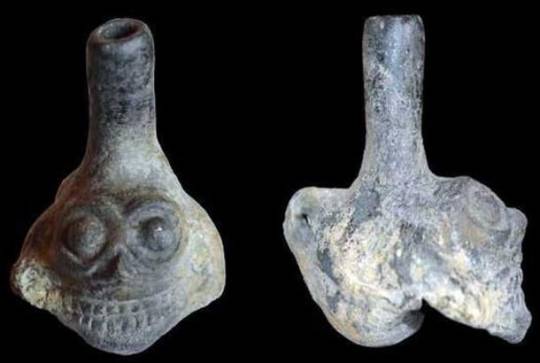
Orgill points out that this is not a “human scream” but rather the sound emitted by the replica of a skull-shaped artifact originally discovered in Mexico City in 1999 by archaeologists.
It was reportedly found clutched in the hand of a headless skeleton in a temple dedicated to the wind god Ehecatl — one of many sites where the Aztecs conducted human sacrifices.
Initially thinking it was a toy, per Orgill, scientists didn’t blow into it until 15 years later, whereupon it emitted a terrifying sound.
“‘It was a startling discovery because it sounded like a screaming human,” said the burgeoning YouTube star, who dubbed it the “most terrifying sound in the world.”


The Aztecs were able to create this nightmarish noise by modeling the death whistle after the human larynx.
When the user blows into the instrument, the wind divides in two, producing oscillating sound waves that bounce around a large chamber before leaving via a second hole.
While the purpose of the instrument remains unclear, experts have several theories, with some believing this fright flute was used to scare enemies in battle.
Others postulate that the whistle was a defense talisman used to ward off evil spirits during a sacrificial victim’s journey to the afterlife.
In order to resurrect this symphony of screams for our listening “pleasure,” Orgill blew into different Tim Burton-esque whistles that were 3D-printed by US tech firm HeyGears.
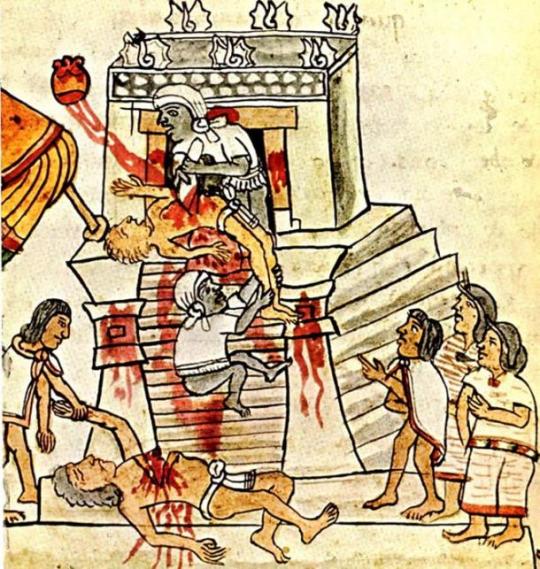


All told, they made the raptor larynx from “Jurassic Park” sound like a kazoo.
No 3D printer, no problem: Interested parties can buy their death whistles on Amazon, which offers duplicates made of materials ranging from resin to carbon fiber.
Many advertise how closely their decibels match that of the most bone-chilling human screams.
By Ben Cost.
#Aztec Death Whistle#The Aztec Death Whistle ‘The Most Terrifying Sound in the World’#Tlatelolco#mexico city#the wind god Ehecatl#ancient artifacts#archeology#archeolgst#history#history news#ancient history#ancient culture#ancient civilizations#aztecs#aztec history#aztec mythology#aztec culture#aztec gods#aztec empire#aztec art
196 notes
·
View notes
Text
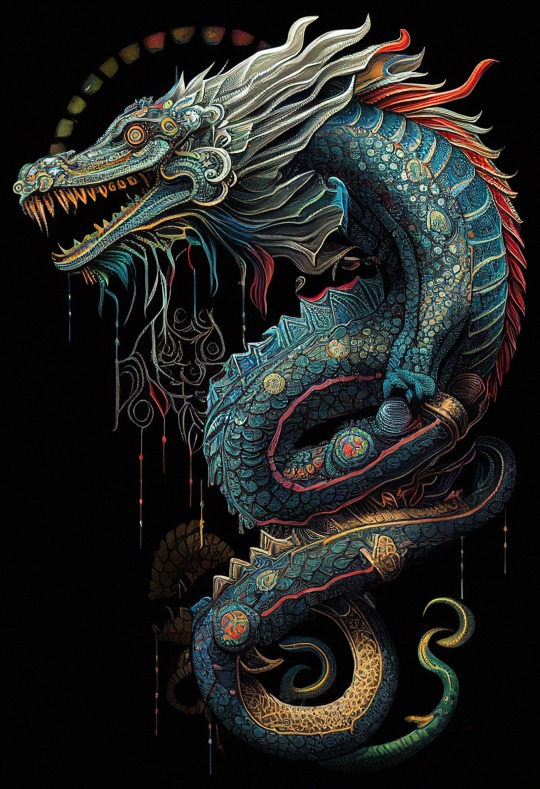
The significance of this day
Day Ehecatl (Wind, known as Ik in Maya) is governed by Quetzalcoatl as its provider of tonalli (Shadow Soul) life energy.
Quetzalcoatl 🐉
Talon Abraxas
The god Quetzalcoatl, is the Feathered Serpent or Precious Twin. He is the god intelligence and self-reflection, a patron of priests.
Quetzalcoatl is a primordial god of creation, a giver of life. With his opposite Tezcatlipoca he created the world. Quetzalcoatl is also called White Tezcatlipoca, to contrast him to the black Tezcatlipoca.
As the Lord of the East he is associated with the morning star, his twin brother Xolotl was the evening star (Venus). As the morning star he was known by the name Tlahuizcalpantecuhtli, "lord of the star of the dawn." An other representation of Quetzalcoatl is Ehecatl, the Wind God. His calendrical name is Ce Acatl (One Reed).
After the last world, the Fourth Sun had been destroyed, Quetzalcoatl went to Mictlan, the land of the death, and created our current world, the Fifth Sun, by using his own blood to give new life to bones. Quetzalcoatl is also the giver of maize (corn) to mankind.
72 notes
·
View notes
Text

Quetzalcoatl, The Feathered Serpent
12 - Ehecatl (wind)
The significance of this day
Day Ehecatl (Wind, known as Ik in Maya) is governed by Quetzalcoatl as its provider of tonalli (Shadow Soul) life energy. Ehecatl is a bad day for working with others. Its influences are inconstant and vain. A good day to root out bad habits.
The Evolution Of The Feathered Serpent God
The name Quetzalcoatl comes from two words in the Aztec Nahuatl language: quetzalli, which means “tail feather of the quetzal bird,” and coatl, the word for snake. Quetzalcoatl, then, was a feathered serpent unlike any other god.
15 notes
·
View notes
Text
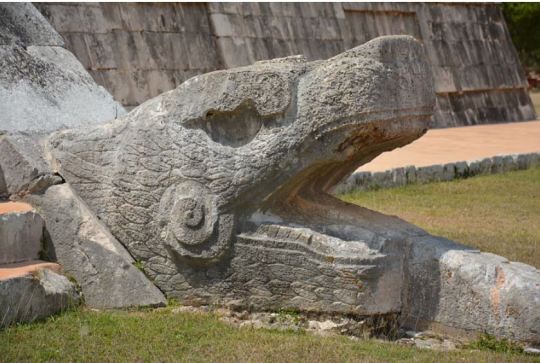
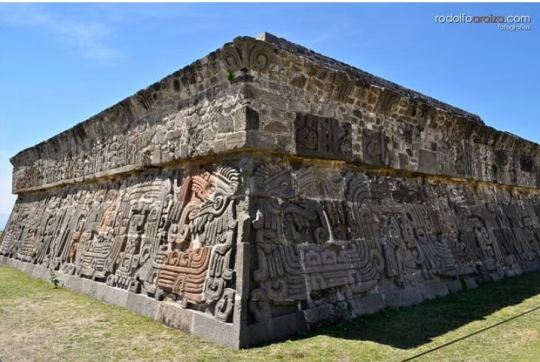

KUKULCAN (pron. Koo-kool-kan) is the name of a feathered serpent god in the mythology and religion of Mesoamerica, in particular, the Yucatec Maya. He is also identified as the feathered serpent god Quetzalcóatl by the Toltecs and Aztecs, as Gucumatz to the Quiché Maya of Guatemala, and Ehecatl, the wind god of the Huastecs of the Gulf Coast.
Kukulcan and his other manifestations are all unified by the belief that each was considered a creator god and a bringer of rain and winds. The god is particularly associated with Chichen Itza where a large temple was built in his honour. Kukulcan is also the name of a 10th-century CE cultural hero in Yucatec Maya history, and he has a counterpart in the Toltec and Aztec histories where he carries the name Ce Acatl Topiltzin Quetzalcóatl. The feathered serpent god remains today a powerful symbol of Mexican indigenous cultural heritage.
Read More Here
240 notes
·
View notes
Text
The Aztecs recognised hundreds, perhaps thousands, of divinities. Gomara observed the gods were " only so many manifestations of the One", which agrees with what Aurelio, a modern Nahua shaman, told Sandstrom: "So many? .. They 're all the same". Certainly no Aztec image has been excavated which is unequivocally of a single divinity. Rather, all statues combine elements of several gods, much as gods inhabit each other's temples, and transform into each other in Aztec myths: "Tezcatlipoca altered his name and changed himself into Mixcoatl" even changing sex, or becoming one another's aspects.
The Nahuatl word for "deity" (teo, teotl) was vague: plural yet singular - akin to "outstandingness", forming compounds such as "ravenous" (teo-ciuhqi) and "in excellent health" (teo-patic). Apparently there was an imageless Being behind divinities, which Aztecs knew as Tloque Nahaque (Lord of the Close Vicinity), Yohualli ehecatl (Night and Wind), Ometeotl (God of Two-ness?), Ipalnemoani (Giver of Life), and Tonacatecuhtli-Tonacahuatli (Lord and Lady of Our Flesh)
Gods and goddesses were the "mirrors" (tezcatl), "suns" or "offspring" of this being, yet often this "High God" is a title or aspect of them
Braden believed this confusion stems from scholars falsely attributing exalted concepts to the Aztecs, but his case is refuted by the Aztecs, who were outraged when Spanish monks told them they did not have "One God, Creator". Haly, following Michael Coe's line of Aztec divinity as "a never-ending pair of dual opposites", considers the "High God" a pair - a "bone god" - the "marrow" or dead shadow of the gods
Probably the fuller picture is Eva Hunt's: that Aztec Divinity was an ever-transforming, multiple Reality that was nature, in a pantheistic fashion. This would explain the Aztec emphasis on birds, beasts as the gods' nahualli (doubles, alter-ego)
Divinities were organised into twin, quadruple and quintuple aspects. These seem to have rotated as each other's "stand-ins" around the Mesoamerican wheels of time and directional space
-Explaining Aztec Human Sacrifice, Kerkhove
very interesting! have never heard a description of aztec religion like this. reminds me a lot of hinduism
13 notes
·
View notes
Text

Seated Figure of the Wind God (Ehecatl)
Aztec
1440-1521
This sculpture depicts the Aztec wind god Ehecatl, bringer of storms and rain. He wears a loincloth and his signature headdress with a central flower motif surrounded by four tassels ending in representations of jade ornaments. The figure’s right hand is clenched in a fist, leaving a hole that may have held a banner or a flag. Such small, intimate sculptures probably adorned sacred shrines and were venerated during festivals associated with the agricultural cycle.
source
2 notes
·
View notes
Note
this is a question to the team themselves. how did you come up with gustatl's typing quirk?
Well, I have to go on a bit of a tangent to answer that. Gustatl's name comes from 2 things. Gust, as in a gust of wind, and Ehecatl, (E-heh-cah-tuhl) also known as Quetzalcoatl. (Kets-all-coh-tuhl) Quetzalcoatl is the most important god in Aztec mythology, and along with many other things, created the wind. He appears in the form of Ehecatl, a bipedal feathered-serpent that looks somewhat like a human in stature. Since Ehecatl is a serpent, we figured that a neat quirk would be that Gustatl slurred his "s" sounds, which include s's, c's, and sometimes x's, (like in the word next) which is a trait mostly given to snake or snake-like characters in media. This also references a sort of spoiler-y detail about Gustatl, being that he pulls from another Aztec mythological entity, the Ouroborus, which, in Aztec mythos, is depicted as a serpent eating it's own tail. It represents both the beginning and the end, and is a metaphor to Gustatl's never-ending lust for power, which ended up "consuming" most of his humanity. Not that he's a human, you get what I mean.
Sorry about the long-winded answer! I could write for hours about all the thought that went into Gustatl's design, personality, origins, and backstory. He's by far my favorite creation, even if I only created certain parts of him. @snakeoilsalemsan originally thought of his concept, after all.
Long story short: Snakes. Have a good one, anon.
-Vic
7 notes
·
View notes
Note
Do you have any thoughts on the title for Lostbelt 7, Nahui Mictlan, implying that the story will be focused on Mesoamerican Mythology rather than South America? Personally, as someone of Peruvian descent, I'm pretty bummed that it implies it won't be taking place in the Andean-Amazon-Brazil regions of South America.
Mictlan is the Aztec Underworld. Nahui means age. The name refers to how the Aztec world lived under Nahui Ocelotl (age of the jaguar) ruled by Tezcatlipoca, but then Quetzalcoatl won their big battle and took over, ushering the world into Nahui Ehecatl (age of the wind).
So Age of the Underworld implies a world not ruled by Quetz nor Tez. And Kotomine mentioned ORT carrying the Xibalba on its back, so it could be the world ruled by ORT. This also strongly implies that all the alien microbes associated with Aztec gods by Quetz's profile come from him. And both forms of Quetz are associated with imagery of the meteor that killed the dinosaurs, so ORT was the meteor.
It's also established that pure-blooded dragons were present in the world long before the Age of Gods, but at an unspecified time for unspecified reasons, they escaped to the Earth’s interior, except for Albion who died trying. Add that to the facts that Kouyou has her T-Rex form based on Kuzuryuu and Anning’s content conflates dinos and dragons sometimes, and then it's very plausible that the pure-blooded dragons were the dinosaurs.
So, from what we've seen from Melusine in Avalon le Fae, this is what a dinosaur actually looks like:

Not feathered enough for my tastes, but that's still a good dino imo.
That's about it my Nahui Mictlan setting theories. It sucks that Amazon won't have genuinely Amazon content, but the Aztec content we're expected to get is more setting-original than genuinely Aztec, so we aren't exactly losing to anyone in the competition, if that somehow makes you feel any better.
38 notes
·
View notes
Text
What if Natlan took inspiration from the Aztec death whistles? (GENSHIN RAMBLE)
08.05.2023 | Note by me: Okay guys, I know Fontaine’s 4.0 trailer just came out and it’s far too early to be talking about Natlan that is going to be released in 5.0, BUT I just came across a fact called the “death whistles” from Ancient Mexico and I ran straight here to share with you guys :) So enjoy the read, fellow Natlan enthusiasts! Please note that this is just a ramble about Natlan’s speculation and their soon to be revealed lore, this post is not indicative of Hoyoverse’s final product.
And since I am going to be talking about things heavily related to cultural references, if you are familiar with/apart of the cultures that is being mentioned, please do correct me if I had made a mistake and feel free to add your thoughts in asks or in the tags below! I will add credits to the websites from which I have found this information from in the bottom of this post. Reblogs and credits are very much appreciated. ^^
(CW: Few swear words below the cut!)
So there is this unique part of Aztec culture called the “death whistle” that originated from ancient Mexico. It’s a kind of whistle shaped into a seemingly humanoid carving with an opening to blow into that creates a bone-chilling sound reminiscent of human screams, animal calls, and howling winds. These whistles come in various shapes and produce different variations of sounds. Here are some pictures I found in Google, so this is what they look like:
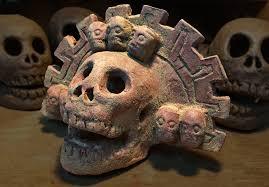

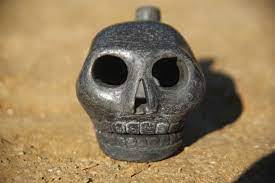

As you may know, Natlan is speculated to be inspired from Pre-Columbian or Indigenous America, alongside influence from Spanish and West African cultures. Either way, it can mean that Natlan may also be inspired from Aztec or early Mexcian cultures and folklore, so it’d make sense that they would add inspiration of the whistles. To list some references of Natlan that we see so far, the nation’s name could be a reference to the language of Nahuatl, meaning “place near where there is abundance [of] Na”. Secondly, the Aztecs worshipped many gods of wars, and Mexico is well-known for its volcanoes, much like Natlan is, and so much more.
Going back, I would conclude that it would be a very interesting and most likely addition if Natlan would include the death whistle which is deeply connected to Aztec and Mexican folklore.
In the immemorial past, these whistles were found in temples that worshipped the wind god Ehecatl (E-he-kah-tl). These whistles were also associated with the Aztec god of death who ruled over the land of the dead from what they call Mictlan, named Mictlāntēcutli (Muhkt-laan-tuh-koot-lee). These instruments were called “whistles of death” because historians believed that they were used to help guide sacrificial victims on their journey to the afterlife. Not only that, but I have also derived information that they were used for religious practices, such as ritual sacrifice, or for something related to battle and war. This fact stood out to me considering Natlan is the Nation of War, and to have these featured in the game’s story would be undoubtedly amazing! And even a good addition to the overall cultural feel and character of Natlan’s dedication to combat. I feel it would enhance the tone of the nation’s lore and even give us a tiny glimpse to the more deeper and darker parts of Genshin lore.
Here is a YouTube link for the sound of the death whistle.
Also, fun fact! Because the whistle is related to the god Ehecatl, the whistles were required to simulate the sounds of the wind because a strong wind cannot be summoned whenever the occasion requires. Interesting isn’t it?
Now, time for my opinions and speculations!
Ever notice how Barbatos and the wind is always vaguely mentioned in the lore of the nations we go through outside of Mondstadt, such as where Barabtos’s seal is strikingly similar to one of the adeptal abodes we visited, or that one letter we found in the Chasm with the Abyss, how Barbatos was vaguely mentioned to be helping Dvorjak to help him in Liyue? Or how the wind god of time, Istaroth, was mentioned in Ei’s Story Quest and the Cecilia flower making appearances in one of the cutscenes in Inazuma? Or maybe you’ve heard of the crazy theories of Irminsul being related to Venti? How about those Anemo vision weilders saving us in each nation we visit? Hahaha, I think I'm going crazy. But.
What if I am not?
Suspiciously enough, from what we’ve learned, these whistles were found in a temple that worships a wind god. You know who else is a god of the wind and has a temple to worship him/her? And the fact that it is also mentioned that a strong wind cannot be summoned in certain occasions, and you know a place in Genshin where the wind does not blow? Yes. Mare Jivari. And surprise, it is also located in Natlan.
I wonder if Venti will be vaguely mentioned once again, but in Natlan. Of all places, he keeps getting mentioned in other nation’s lore. If this is the case, and Venti’s motifs (Wind, song, poetry, cecilias, etc. You get the gist.) OR his god status as Barbatos. If this continues in Fontaine and this happens to be true in Natlan, or even throughout the story in Snezhnaya, then this cannot be a coincidence. After all, we’ve gotten information about Barbatos’s connection with the Tsaritsa, their fallout, and how she is jealous of his power.
Moving on.
I think it would be scary and cool at the same time if we hear that the whistles could even be used in war in Natlan. Perhaps to drive, scare, and even torment their enemies? If Hoyoverse’s writing team would be so bold and even take a step further to amplify Natlan’s culture surrounding war and battle, and even show us as the audience that these people are far more fearsome than they seem, then the death whistle would be such a kickass addition. Who among the people could have discovered it? Their Archon?
Come on, Hoyoverse, don’t be shy. You’ve given us psychological horror from Sumeru’s samsara, Dottore’s experiments, an execution surrounding the God of Eternity’s extra-special technique, now give us some feral fire-bending tribes who could go absolutely apeshit and don’t hesitate to fuck around their enemies like they wanted. Let them do it in honor of war. In honor of the Lady of Fire. Show us that they are tribes that belong to the art of combat. That they are true tribesmen and women that shall serve War at any cost.
Anyway, that is all that I have to share, thank you for reading! And here are the links to the websites from which I got the info!
#genshin impact#natlan#natlan genshin impact#nation of war#genshin ramble#venti#venti genshin impact#barbatos#PHEW this took longer than i expected!#anyway#i'd like to have some people to talk to about#ill be waiting for you guys' thoughts!!!
5 notes
·
View notes
Text
Came across something on research haunts, and did the Bat Queen give Eda an Aztec Death Whistle?


Aztec Death whistles were psychological war instruments used to unnerve enemies during war. They were dedicated to the Wind God Ehecatl and when blown “ sound[ed] like ghosts screaming in the wind.”
Another curious use of the Aztec Death Whistle was as conductor for departed souls. Used in the Day of the Dead celebrations, these instruments helped guide the souls of the departed into the afterlife, both comrades and enemies.
The implications of this favor cannot be understated. If Luz and Co are going to be fighting Belos when the veil between worlds is at its thinnest ie Halloween, then the argument can be made that they can contact other realms too. Eda might use this whistle, ( the Bat Queen can remind her/ tell her of its properties) and pierce the veil, thereby creating a doorway of sorts between the two.
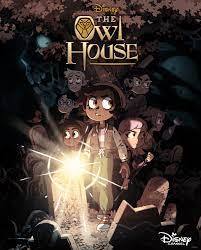
The whistle can also be used to call forth all the spirits of the witches and creatures that fell under Belos’s tyranny. He clearly still can’t control the absorbed Palismen. Going on the theory that the Palismen are so intricately entwined with their owners past or present, then they can act as anchor of sorts to call back their dead owners into the World of the Living when the whistle is blown.
I think this is why the Bat Queen was so adamant at protecting them in the forest; She protects them all. She knows there might come a time when the balance of the world is near undone by Belos and they’ll need every bit of help to make things right and the Palismen left behind after their owners’ petrification are the only bridge towards that reality.

14 notes
·
View notes
Text
Ga-Oh, or Gaoh. Master of the Winds.

SYMBOLS: The Western sky, a lodge with four doors, the four animals that are leashed to the doors of his lodge, a bear, panther, moose & fawn.
USUAL IMAGE: A giant Iroquois warrior.
HOLY DAYS: No feast day of his own.
FORM OF WORSHIP: Not so much worshipped as understood as a higher power in charge of an elemental force of nature that sometimes brought good things and sometimes brought terrible things, but had to be respected no matter what.
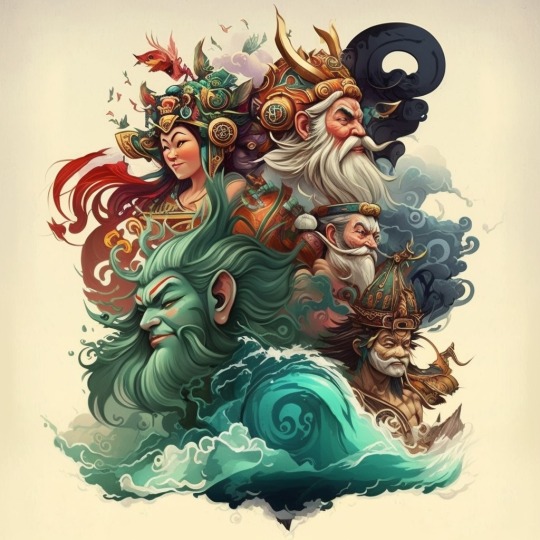
SYNODEITIES: Ehecatl (Aztec), Fei Lian (China), Futen (Japan), Michabo (Algonquian), Njord (Iceland, Nordic), Stribog (Slavic), Vayu (Iranian), Zephyrus the West Wind (Greek) along with his brothers Boreas the North Wind, Notus the South Wind, Apheliotes the East Wind.
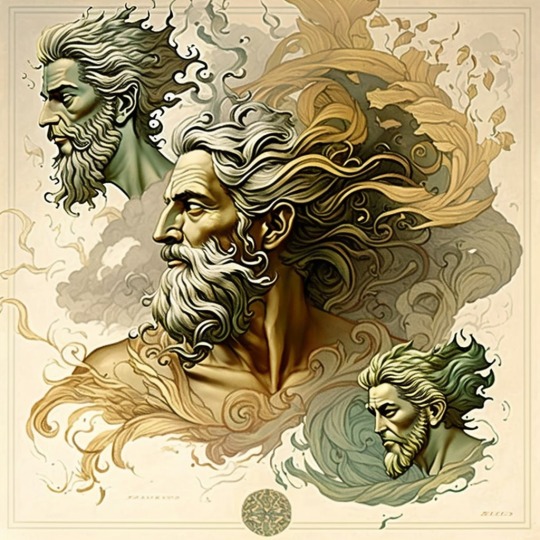

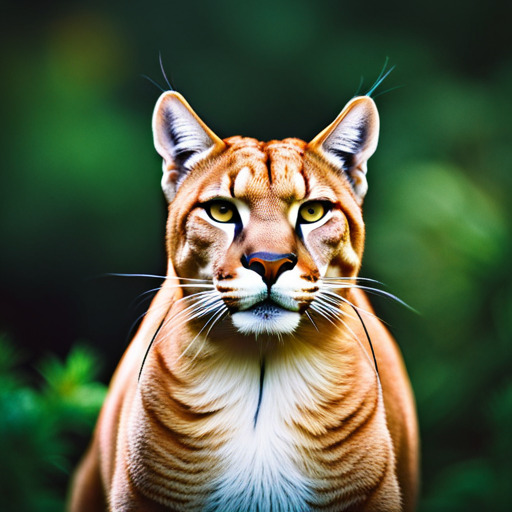

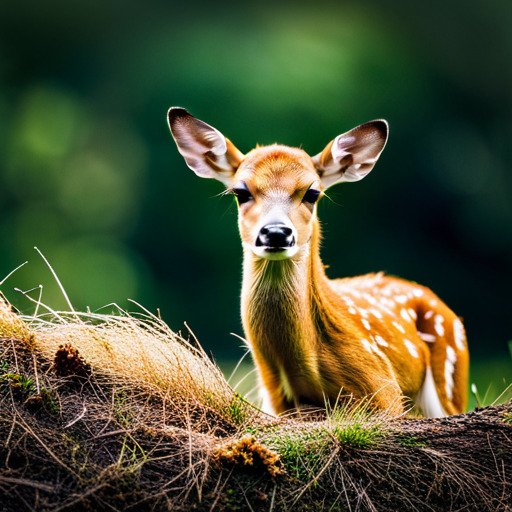
DETAILS: Gaoh was the Iroquois people’s Master of the Winds. He was said to be a giant who kept his lodge of four doors in the Western sky. He was so powerful that there was nowhere he could not move.
So great was his power he was in danger of tearing the world apart. To keep this from happening, he sat in the middle of his lodge and sent out a call that was heard over the whole land. Soon, he heard four animals coming in to answer his call.
The first to arrive was Bear, who was outside his North door. At the same time, a fierce storm with thick snow and freezing wind raged around Gaoh’s lodge. Because of his strength, Gaoh set Bear a place at his North door and put him in charge of the Northern winds.
Next came Panther, who showed up at his Western door bringing with him whirlwinds, tempests, and shrieking and moaning winds; because of this, Gaoh placed a leash around his neck and made a place for him by his Western door giving Panther charge of Winds of the West that could tear down forests.
After Panther was put by the West door, the sky turned gray, and he started to sob; opening his Eastern door, Gaoh saw that Moose was there; because of this, he lashed him by that door and gave him charge of the cold, wet winds and gray mists of the East.
Knowing that things were not yet finished, Gaoh threw open his Southern door, which brought to him a gentle breeze that carried with it the scent of a thousand flowers, and the songs of a thousand birds; outside the Southern door was a shy fawn whom Gaoh invited into his lodge and put in charge of the Summer winds so that after that whenever a pleasant breeze was felt in the Summer, it was said that the fawn was returning home to its mother.
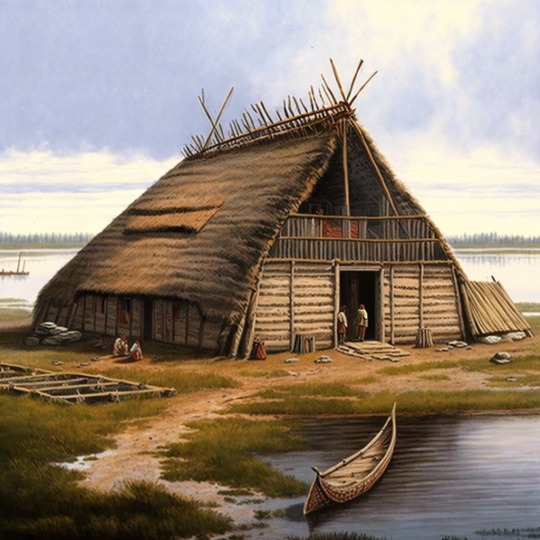
Ga-oh was a god of the Iroquois people, one of the oldest democratic governments on Earth, and the tribe that had the most critical impact on the United States.
A confederation of five nations, with a sixth non-voting tribe, the Tuscarora, added in 1722, the Iroquois, which was not what they called themselves; that name is a combination of what the Algonquins called them “rattlesnakes” with the French suffix “ois.” They called themselves The People of the Long House or Haudenosaunee.

The Nation was made up of the Cayuga “those of the great pipe” Mohawk “people of the Flint,” Oneida “people of the standing stone,” Onondaga “people of the hill,” Seneca “keepers of the Western door,” & Tuscarora “shirt wearing people.” At its most significant, it stretched from Niagara Falls and Upper New York to the junction of the Ohio & Mississippi rivers.
A matrilineal society, the Iroquois and not the Greeks supplied the main inspiration that would eventually become the American Republic.
They were also Notable for some fascinating mythic creatures, such as the Giant Flying Heads, whom one had to be very careful of on stormy nights, and Onatah, a goddess very similar to Persephone.


2 notes
·
View notes
Text

Quetzalcóatl
Talon Abraxas
The god Quetzalcoatl, is the Feathered Serpent or Precious Twin. He is the god intelligence and self-reflection, a patron of priests.
Quetzalcoatl is a primordial god of creation, a giver of life. With his opposite Tezcatlipoca he created the world. Quetzalcoatl is also called White Tezcatlipoca, to contrast him to the black Tezcatlipoca.
As the Lord of the East he is associated with the morning star, his twin brother Xolotl was the evening star (Venus). As the morning star he was known by the name Tlahuizcalpantecuhtli, "lord of the star of the dawn." An other representation of Quetzalcoatl is Ehecatl, the Wind God. His calendrical name is Ce Acatl (One Reed).
After the last world, the Fourth Sun had been destroyed, Quetzalcoatl went to Mictlan, the land of the death, and created our current world, the Fifth Sun, by using his own blood to give new life to bones. Quetzalcoatl is also the giver of maize (corn) to mankind.

67 notes
·
View notes
Text

Day Ehecatl (Wind, known as Ik in Maya)
is governed by Quetzalcoatl as its provider of tonalli (Shadow Soul) life energy.
Ehecatl is a bad day for working with others. Its influences are inconstant and vain. A good day to root out bad habits.
9 notes
·
View notes
Text
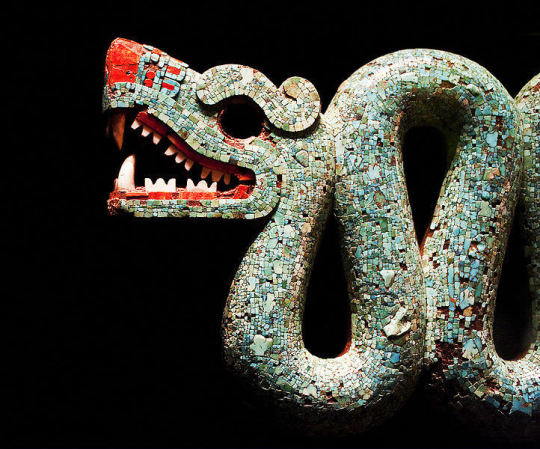





THE Aztecs of northern Mesoamerica (c. 1345 and 1521 CE) worshipped some of the weirdest, most fantastic and downright scary gods seen anywhere in history. The Aztec civilization and the empire it created revolved around winning special favour with these gods in order to ensure a measure of balance in nature, the continuance of human life and even the daily rising of the sun itself. In this collection we examine 15 gods in detail, looking at the mythology they were involved in and their particular associations such as their special days, numbers and animals. Here are all the major gods from mighty Huitzilopochtli, Hummingbird of the South, and his links with war and eagles to mischievous Xochipilli, the Flower Prince, linked to summer, butterflies and poetry.
The top 15 Aztec gods were:
Huitzilopochtli - the supreme god of the Sun and war.
Tezcatlipoca - the ever-present creator god and patron deity of warriors.
Tlaloc - god of rain, water, lightning, and agriculture.
Quetzalcóatl - god of winds and rain and the creator of humanity.
Coatlicue - the earth-mother goddess.
Tlaltecuhtli - the earth goddess associated with fertility.
Mictlantecuhtli - ruler of the underworld
Tonatiuh - god of the present and fifth Sun.
Coyolxauhqui - goddess of the Moon.
Mixcoatl - god of hunting, the Milky Way, and the stars
Ehecatl - god of air and winds.
Tlahuizcalpantecuhtli - god who represented a menacing aspect of Venus.
Xiuhtecuhtli - god of fire.
Xipe Totec- god of spring, seeds, and planting.
Xochipilli - god of summer, flowers, love, and dancing.
Read more here
342 notes
·
View notes